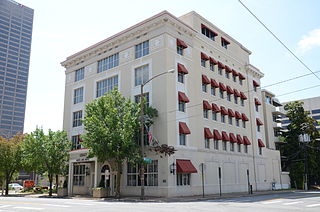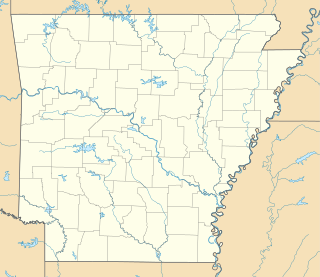
The Old State House, formerly called the Arkansas State House, is the oldest surviving state capitol building west of the Mississippi River. It was the site of the secession convention, as well as the fourth constitutional convention when delegates agreed to ensure voting rights for freedmen and establish public education.

The Tower Building of the Little Rock Arsenal, also known as the Main Building of the U.S. Arsenal at Little Rock, or Headquarters Building of the Little Rock Barracks, is the home of the MacArthur Museum of Arkansas Military History. It is also a part of the MacArthur Park Historic District, in Little Rock, Arkansas.

Little Rock is the capital and most populous city of the U.S. state of Arkansas. As the county seat of Pulaski County, the city was incorporated on November 7, 1831, on the south bank of the Arkansas River close to the state's geographic center. The city derived its name from a rock formation along the river, named the "Little Rock" by the French explorer Jean-Baptiste Bénard de la Harpe in the 1720s. The capital of the Arkansas Territory was moved to Little Rock from Arkansas Post in 1821. The city's population was 197,312 in 2019 according to the United States Census Bureau. The six-county Little Rock-North Little Rock-Conway, AR Metropolitan Statistical Area (MSA) is ranked 78th in terms of population in the United States with 738,344 residents according to the 2017 estimate by the United States Census Bureau.

George Richard Mann was a United States architect, trained at MIT, whose designs included the Arkansas State Capitol. He was the leading architect in Arkansas from 1900 until 1930, and his designs were among the finalists in competitions for the capitols of several other states.

John Parks Almand was an American architect who practiced in Arkansas from 1912 to 1962. Among other works, he designed the Art Deco Hot Springs Medical Arts Building, which was the tallest building in Arkansas from 1930 to 1958. Several of his works, including the Medical Arts Building and Little Rock Central High School, are listed on the National Register of Historic Places.

St. Peter's Rock Baptist Church is a historic former church building at 1401 West 18th Street in Little Rock, Arkansas. It is a two-story vernacular brick structure, its main facade featuring a slightly recessed central section with a gable topped by a cross above. The church was built in 1941 for an African-American congregation established in the 1890s. This was the congregation's first purpose-built home, which it occupied until moving to larger quarters on Brown Street in 1975. It has been owned since then by the Greater Little Rock Singing Quartet Center, and continues to serve as a community meeting and performance space.

The Immaculate Heart of Mary Church is a historic Roman Catholic church in northern Pulaski County, Arkansas. It is located off Arkansas Highway 365 on Blue Hill in Marche, north of North Little Rock.

The Van Buren Historic District encompasses eight blocks of historic buildings along Main Street in Van Buren, Arkansas. Many of the structures are pre-1920 Victorian and Italianate buildings closely related to the history of commerce in the city. Positioned between the city's train depot and the Arkansas River, the businesses constituting the Van Buren Historic District have played a vital role in the history and economy of the city and region. The district was placed on the National Register of Historic Places as a National Historic District on April 30, 1976.

The Exchange Bank building is a historic commercial building at Washington and Oak Streets in El Dorado, Arkansas. Built in 1926–27, the nine story building was the first skyscraper in Union County, and it was the tallest building in El Dorado at the time of its listing on the National Register of Historic Places in 1986. It was designed by the Little Rock firm of Mann & Stern, and is an eclectic mix of Venetian-inspired Revival styles. It was built during El Dorado's oil boom, and housed the headquarters of Lion Oil. It was included in the El Dorado Commercial Historic District in 2003.

Curran Hall, also known as the Walters-Curran-Bell House, is a historic house at 615 East Capitol Street in Little Rock, Arkansas. It was built in 1842 for Colonel Ebenezer Walters. The single story house is built in the Greek Revival style with Doric pilasters at the entrance way. Two auxiliary buildings, constructed at about the same time as the main building, were moved and attached to the rear of the house in 1891.

The Hotel Fredeirica is a historic commercial building at 625 West Capitol Avenue in Little Rock, Arkansas. The five-story building was built in 1914 and enlarged in 1941. The original building was designed by Theodore M. Sanders, and the addition by Edward Durell Stone, both prominent Arkansas architects. Both sections of the building are excellent representatives of their architectural styles: the older in a typical early 20th-century commercial style, and the addition in the International style.

The Robert E. Lee School is a historic former school building at 3805 West 12th Street in Little Rock, Arkansas. Now a local community and social service center, this Collegiate Gothic revival two-story masonry building was built in 1906-07 and twice enlarged. The original design was by Gibb & Sanders, and the additions were by Theo Sanders (1910) and Thomas Harding, Jr. (1930). The city used the building as a school until 1971. In the 1990s it was used as a teacher training facility, and was in 2005 repurposed as a community center.

The James Mitchell School is a historic school building at 2410 South Battery Street in Little Rock, Arkansas. The oldest portion of the building is a four-room structure designed by Charles L. Thompson and built in 1908. It was enlarged several times, notably by Thompson in 1910, and Thomas Harding, Jr. in 1915, and 1952. Harding's addition gave the building its prominent Classical Revival entrance portico. The school property includes two outbuildings that also houses classrooms. The school was originally a segregated facility, serving only white students, but the end of segregation transformed the school into one that served its predominantly black neighborhood. It was closed in 2005.

The U.M. Rose School is a historic school building at the corner of Izard and West 13th Streets, on the campus of Philander Smith College in Little Rock, Arkansas. A two-story U-shaped Colonial Revival brick building, it was built in 1915 to a design by Arkansas architect Charles L. Thompson, and was called "by far the best constructed" of any building in Little Rock.

The YMCA–Democrat Building is a historic commercial building at East Capitol and Scott Streets in downtown Little Rock, Arkansas. It is a three-story masonry structure, built out of brick with molded stone trim. Built in 1904, its restrained Renaissance Revival designs have been obscured to some extent by later alterations. It was designed by Sanders & Gibb, a prominent local architectural firm, and originally housed the local YMCA before later becoming home to the Arkansas Democrat-Gazette, one of the state's leading newspapers.

The Ross Building is a historic commercial building at 700 South Schiller Street in Little Rock, Arkansas. It is a single-story masonry structure, whose front facade features five bay windows sheltered by awnings, and a high parapet with cornice above. A major extension to the rear is covered by a hip roof, and includes space historically used both by its retail tenants and as residences for owners and employees. The building was built in 1896–97, and originally housed a grocery store serving the area's predominantly German-American population. It has since gone through a significant number of other commercial uses; although its exterior retains many original features, its interior has been heavily modified.

The Mosaic Templars State Temple is a historic African-American fraternal benefit society building at 906 South Broadway Street in Little Rock, Arkansas. It is a two-story masonry structure, built of brick an terra cotta. The front facade is symmetrical, with ornately decorated elements rising to a parapet. It was built in 1921 to house the headquarters of the state chapter of the Mosaic Templars of America, an African-American fraternal society founded by former slaves after the American Civil War. The building was part of a complex which originally included three buildings, one of which was the organization's national headquarters; the other two buildings were destroyed by fire.

The Garland Elementary School is a historic former school building at 3615 West 25th Street in Little Rock, Arkansas. It is a square two-story masonry structure, finished in red brick with stone trim. Some of its original Gothic entrances have been obscured by later additions. The school was built in 1924, with additions in 1938 and 1954, and was originally built to serve the local white student population. It was named for Augustus H. Garland, a local politician. The school was fully integrated in 1973, and closed in 2001.

The Fulk-Arkansas Democrat Building is a historic newspaper headquarters building at 613-615 Main Street in Little Rock, Arkansas. It was built in 1916 by the estate of Francis Fulk, a prominent local judge, and was designed by Charles L. Thompson. It was built on the foundation of a 1911 structure that was destroyed by fire before it was finished. It was occupied by the Arkansas Democrat newspaper from 1917 until 1930, when it moved to the YMCA–Democrat Building. The building is of architectural importance for its association with Thompson, and its surviving Classical Revival details.

The Arkansas Teachers Association Headquarters Building and Professional Services Building are a pair of historic commercial buildings at 1304 and 1306 Wright Street in Little Rock, Arkansas. Occupying adjacent lots with a shared parking area and landscaping, the two buildings are both single-story brick structures, designed by George Tschiemer & Associates and built in the early 1960s. The buildings were listed as a pair on the National Register of Historic Places in 2018, for the role of the Arkansas Teachers Association, an association of African-American educators, in its work during the Civil Rights Era of the 1960s to end segregation in the state.



















